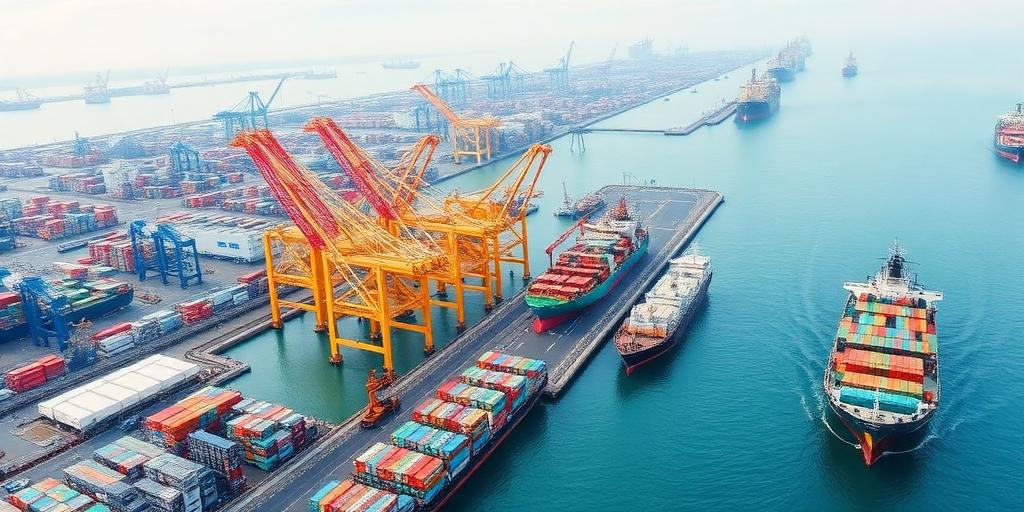Sagarmala Project 2025: A Sarkari Yojana Driving Port-Led Development
The Sagarmala Project, an ambitious initiative by the Indian government, aims to revolutionize the country's logistics sector by leveraging its extensive coastline and waterways. Launched in 2015, this project envisions port-led development through comprehensive infrastructure upgrades, enhanced connectivity, and streamlined processes. As we approach 2025, it is crucial to assess the project's progress, impact, and future trajectory.
Project Overview
The Sagarmala Project is not merely about developing ports; it's a holistic approach to integrate ports with industrial clusters, inland waterways, and the national rail and road network. The project encompasses four key pillars:
- Port Modernization: Upgrading existing ports to enhance capacity and efficiency through automation, digitization, and infrastructure improvements.
- Port Connectivity Enhancement: Building new roads, rail lines, and inland waterways to facilitate seamless cargo movement from ports to hinterland.
- Port-led Industrialization: Developing coastal economic zones (CEZs) and industrial clusters near ports to promote manufacturing and reduce logistics costs.
- Coastal Community Development: Improving the livelihoods of coastal communities through skill development, employment generation, and infrastructure development.
Key Objectives
The Sagarmala Project is driven by several strategic objectives:
- Reducing Logistics Costs: Lowering overall logistics costs by optimizing transportation and handling processes.
- Boosting Exports and Imports: Enhancing port capacity to handle increased trade volumes, thereby boosting exports and imports.
- Creating Employment Opportunities: Generating direct and indirect employment in port-related industries and services.
- Promoting Sustainable Development: Ensuring environmentally sustainable port operations and industrial development.
- Enhancing Regional Connectivity: Improving connectivity to neighboring countries through coastal shipping and transshipment hubs.
Progress and Achievements
Since its inception, the Sagarmala Project has made significant strides in various areas:
- Port Capacity Expansion: Several major ports have undergone capacity expansion projects, including the development of new berths, terminals, and handling equipment.
- Connectivity Projects: Numerous road and rail projects have been completed to improve port connectivity, such as the Dedicated Freight Corridor (DFC) and the Bharatmala Pariyojana.
- Inland Waterway Development: The National Waterway (NW) network has been expanded and upgraded to promote inland water transport as a cost-effective and environment-friendly mode of transportation.
- Coastal Economic Zones (CEZs): The development of CEZs is underway in several coastal states, attracting investments in manufacturing, processing, and logistics.
Challenges and Way Forward
Despite the progress, the Sagarmala Project faces several challenges that need to be addressed to achieve its full potential:
- Land Acquisition: Delays in land acquisition for port and connectivity projects can hinder project implementation.
- Environmental Clearances: Obtaining environmental clearances for port development and industrial projects can be a lengthy and complex process.
- Coordination Issues: Effective coordination among various government agencies, port authorities, and private stakeholders is crucial for seamless project execution.
- Financing Constraints: Securing adequate financing for large-scale infrastructure projects remains a challenge.
To overcome these challenges, the following measures are recommended:
- Streamlining Land Acquisition: Implementing a transparent and efficient land acquisition process with fair compensation for landowners.
- Expediting Environmental Clearances: Simplifying the environmental clearance process while ensuring stringent environmental safeguards.
- Enhancing Coordination: Establishing a dedicated coordination mechanism to facilitate seamless communication and collaboration among stakeholders.
- Attracting Private Investment: Creating a conducive investment climate to attract private sector participation in port and infrastructure projects.
Conclusion
The Sagarmala Project represents a transformative initiative with the potential to reshape India's logistics landscape and drive economic growth. By focusing on port modernization, connectivity enhancement, and port-led industrialization, the project aims to reduce logistics costs, boost trade, and create employment opportunities. As we approach 2025, concerted efforts are needed to address the challenges and accelerate project implementation to realize the full benefits of the Sagarmala Project.









